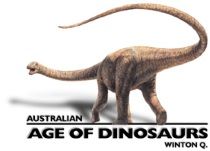Rhoetosaurus brownei
 Pronunciation
Pronunciation
Ree-toss-sore-us brown-eye
Meaning
[Arthur] Browne’s (the station manager) Rhoetos (a titan of Greek myth) lizard
Period
Middle Jurassic (167–165 Mya)
Discovery and publication
Discovered near Roma, Queensland, in 1924 on Durham Downs station (the site is now on Taloona Station, it is a subdivision of the original holding).
In 1926 Heber Albert Longman named and described Rhoetosaurus with Arthur Jemotte Browne’s assistance, Longman collected more bones in 1926 and described these in 1927. Dr Mary Wade and Dr Alan Bartholomai were able to relocate the site in 1975, in the process recovering partial limb bones. The following year, Mary Wade returned to the site again with Dr Richard Anthony “Tony” Thulborn and they discovered an almost complete back foot along with other remains. University of Queensland Ph.D. candidate Jay Nair is revising Rhoetosaurus and published a description of the shin, ankle and foot in 2012. The original Rhoetosaurus specimens are held in, and are still being prepared at, the Queensland Museum to this day.
Description
The only known skeleton of Rhoetosaurus represents the most complete sauropod skeleton ever found in Australia (narrowly beating Diamantinasaurus). More than 40 vertebrae (from the neck, back, hips and tail), parts of the pelvis, and an almost complete right back leg have been found.
The bones of Rhoetosaurus were found in Middle Jurassic aged rocks and represent the second oldest dinosaur bones discovered in Australia (after Ozraptor from Western Australia). Rhoetosaurus is clearly a primitive form of sauropod, although we are unsure precisely where it sits on the lower branches of the sauropod family tree. At about 14–16m long and 3–3.5m at the hip, Rhoetosaurus was a medium-sized sauropod.
